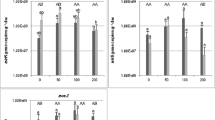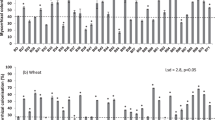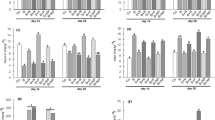Summary
Bacterial biomass and numbers of bacterivorous naked amoebae were estimated daily in soil associated with barley roots and, to avoid the influence of roots, in soil from a field in its fifth summer under bare fallow. The estimates were associated with two rainfall events and were started just before the first. Increases in bacteria were observed after each rainfall, and bacterial production was about the same size for both treatments. A peak in naked amoebae followed each burst of bacterial production in the root-associated soil, whereas in the fallowed soil protozoan production was low after the first rainfall and undetectable after the second. The bacterial populations in the fallowed soil had yet to decline by the end of the 12-day study, probably because grazing pressure by protozoa was low. Calculations based (1) on short-term decreases in bacterial biomass in soil close to roots or (2) on the amount of C added to the soil by plants over the growing season indicated that N released via bacterial-protozoan interactions contributed 10%–17% of the N taken up by the fertilized barley.
Similar content being viewed by others
References
Andrén O (1987) Decomposition of shoot and root litter of barley, lucerne and meadow fescue under field conditions. Swed J Agric Res 17:113–122
Bamforth SS (1976) Rhizosphere-soil microbial comparisons in subtropical forests of southeastern Louisiana. Trans Am Microsc Soc 95:613–621
Bergström L (1986) Distribution and temporal changes of mineral nitrogen in soils supporting annual and perennial crops. Swed J Agric Res 16:105–112
Burnbanck WD (1942) Physiology of the ciliate Colpidium colpoda: I. The effect of various bacteria as food on the division rate of Colpidium colpoda. Physiol Zool 15:342–362
Clarholm M (1981) Protozoan grazing of bacteria in soil — impact and importance. Microb Ecol 7:343–350
Clarholm M (1985a) Interactions of bacteria, protozoa and plants leading to mineralization of soil nitrogen. Soil Biol Biochem 17:181–187
Clarholm M (1985b) Possible roles for roots, bacteria, protozoa and fungi in supplying nitrogen to plants. In: Fitter AH, Atkinson D, Read DJ, Usher MB (eds) Ecological interactions in the soil. Spec Publ No 4, Br Ecol Soc, Blackwell, Oxford, pp 355–365
Clarholm M, Rosswall T (1980) Biomass and turnover of bacteria in a forest soil and a peat. Soil Biol Biochem 12:49–57
Cox WJ, Reisenauer HM (1973) Growth and ion uptake by wheat supplied nitrogen as nitrate or ammonium or both. Plant and Soil 38:363–380
Cutler DW, Crump LM, Sandon H (1922) A quantitative investigation of the bacterial and protozoan population of the soil, with an account of the protozoan fauna. Phil Trans R Soc B 211:317–350
Darbyshire JF, Greaves MP (1967) Bacteria and protozoa in the rhizosphere of Sinapis alba L., Trifolium repens L. and Lolium perenne L. Can J Microbiol 13:1057–1068
Darbyshire JF, Wheatley RF, Greaves MP, Inkson RHE (1974) A rapid micromethod for estimating bacterial and protozoan populations in soil. Rev Ecol Biol Soil 11:465–474
Dive D (1973) La nutrition holozoique des protozoaires ciliés: Ses conséquences dans l'épuration naturelle et artificielle. Ann Biol 12:343–380
Elliott ET, Coleman DC (1977) Soil protozoan dynamics in a shortgrass prairie. Soil Biol Biochem 9:113–118
Elliott ET, Coleman DC, Ingham RE, Trofymow JA (1984a) Carbon and energy flow through microflora and microfauna in the soil subsystem of terrestrial ecosystems. In: Klug MJ, Reddy CA (eds) Current perspectives in microbial ecology. Am Soc Microbiol, Washington DC, pp 424–433
Elliott ET, Horton K, Moore JC, Coleman DC, Cole CV (1984b) Mineralization dynamics in fallow dryland wheat plots, Colorado. Plant and Soil 76:149–155
FAO-UNESCO (1974) Soil map of the world, vol 1. Geneva, FAOUNESCO
Fenchel T (1982) Ecology of heterotrophic microflagellates: 11. Bioenergetics and growth. Mar Ecol Prog Ser 8:225–231
Fenchel T (1987) Ecology of protozoa. Brock/Springer Series in contemporary bioscience, Berlin Heidelberg New York
Fenchel T, Blackburn TH (1979) Bacteria and mineral cycling. Academic Press, New York London
Goldman JC, Caron DA, Andersen DK, Dennett MR (1985) Nutrient cycling in microflagellate food chains: I. Nitrogen dynamics. Mar Ecol Prog Set 24:231–242
Haider K, Mosier A, Heinemeyer O (1987) The effect of growing plants on denitrification at high nitrate concentrations. Soil Sci Soc Am J 51:97–102
Hansson A-C, Pettersson R, Paustian K (1987) Shoot and root production and nitrogen uptake in barley with and without nitrogen fertilization. Z Acker/Pflanzenbau 158:163–171
Hunt HW Coleman DC, Ingham ER, Ingham RE, Elliott ET, Moore JC, Rose SL, Reid CPP, Morley CR (1987) The detrital food web in a shortgrass prairie. Biol Fertil Soils 3:57–68
Lucas MI, Probyn TA, Painting SJ (1987) An experimental study of microflagellate bacterivory: Further evidence for the importance and complexity of microplanctonic interactions. S Aft J Mar Sci 5:791–808
Page FC (1967) Taxonomic criteria for limax amoebae with description of 3 new species of Hartmannella and 3 of Valkampfia. J Protozool 14:499–521
Paustian K, Andrén O, Bostrom U, Clarholm M, Hansson A-C, Johansson G, Lindberg T, Pettersson R, Sohlenius B (1989) Carbon and nitrogen budgets for four agroecosystems with annual and perennial crops with and without fertilization. J Appl Ecol (in press)
Pettersson R (1989) Above-ground growth dynamics and net production of spring barley in relation to nitrogen fertilization. Swed J Agric Res (in press)
Schnürer J, Clarholm M, Bostrom S, Rosswall T (1986a) Effects of moisture on soil organisms and nematodes: A field experiment. Microb Ecol 12:217–230
Schnürer J, Clarholm M, Rosswall T (1986b) Fungi, bacteria and protozoa in soil from four arable cropping systems. Biol Fertil Soils 2:119–126
Singh BN (1941 a) Selectivity in bacterial food by soil amoebae in pure and mixed cultures and in sterilized soil. Ann Appl Biol 28:52–64
Singh BN (194l b) The influence of different bacterial food supplies on the rate of reproduction of Colpoda steinii, and the factors influencing encystation. Ann Appl Biol 28:65–73
Steen E, Jansson PE, Persson J (1984) Experimental site of the ‘Ecology of Arable Land’ project. Acta Agric Scand 34:153–166
Van Veen JA, Ladd JN, Frissel MJ (1984) Modelling C and N turnover through the microbial biomass in soil. Plant and Soil 76:257–274
Author information
Authors and Affiliations
Rights and permissions
About this article
Cite this article
Clarholm, M. Effects of plant-bacterial-amoebal interactions on plant uptake of nitrogen under field conditions. Biol Fert Soils 8, 373–378 (1989). https://doi.org/10.1007/BF00263171
Received:
Issue Date:
DOI: https://doi.org/10.1007/BF00263171




